Kimberley Boab Tree
Boab trees are a wonder. Article for mature and senior travellers about this distinctive tree in Western Australia. Join a small group tour for couples and solo travellers exploring the Kimberley.
16 Jun 21 · 10 mins read

Boab Tree: Botanical Symbol of the Kimberley
Endemic exclusively to the Kimberley region of Western Australia, Boab trees be found from the West Kimberley coast to as far east as the Victoria and Fitzmaurice rivers in the Northern Territory. From Broome through to Kununurra, they’re a common sight. Growing at sea level to elevations of about 300m, they emerge from all types of soils: sandstone hillsides, sandy plains, basalt slopes and sharp limestone ridges. Some are believed to be 1500 to 2000 years old, making them the oldest beings in Australia and amongst the oldest in the world.
They grow rather slowly, but a mature boab tree is a special sight. Each one is entirely unique in shape, with distinctive characteristics that often served as easily recognisable land marks by white settlers. They can grow to up to 15 metres in height, with a swollen, bulbous trunk that can reach a massive girth of up to 20 metres, from which writhing branches sprout. The shape of the large trunk is why it is often referred as the ‘bottle tree’.
The trees are deciduous, losing their leaves during the winter months, known as the ’dry season’ in the tropics. They stand as grey brown skeletons until the wet season approaches around September/October and new growth commences. Flowering can start as early as October; big, fragrant, creamy flowers burst into white and pink. The fruit starts setting around January.
This article explores the boab tree’s mysterious arrival in the Kimberley, its historic use by Aboriginal people, and famous examples to be visited. It is intended as background reading to Odyssey Traveller’s 15-day Tour of Australia’s Kimberley – the home of the boab tree – for senior and mature travellers. Much of the information from this article is drawn from Pat Lowe’s The Boab Tree, as well as sources linked to throughout the article.

How did the Boab Tree Arrive in the Kimberley?
Surrounded by small, drought-resistant, rough-barked evergreen trees, wattle scrub, and grasslands, the boab trees appear like strangers in the Kimberley bush of Western Australia.
The closest relatives to the Australian boab are found far away across the Indian Ocean, in Africa and Madagascar. Of the eight species of boab (or baobab) trees in the world, six are native to Madagascar, one to Africa, and one to Australia. A different species from the other seven, the Australian boab could simply have been introduced from Madagascar or Africa, but must have been here long enough to evolve into its present distinct form. So then how did it arrive here?

No one knows for sure, but one theory suggests that boabs existed in parts of the supercontinent Gondwanaland, which split up to become Africa, Madagascar and Australia between 160 and 50 million years ago. Genetic analysis of boab species from both sides of the Indian Ocean shows, however, that modern boab species are not old enough for this to be plausible. The three major branches separated just over 6 million years ago, long after Gondwanaland had split up.
Furthermore, other lands that were once components of Gondwanaland and fall within the latitudes favoured by boabs, such as South America and the Indian sub-continent, do not have their own species as would be expected.
Also, Australia’s location has varied to an extreme extent over the millions of years. For a long time after its split from Gondwanaland, it was closer to the South Pole, and then it drifted to its present position some 30 million years ago. The Boab species could not have survived such extreme climate variations.
With this theory unlikely, the most possible alternative for the boab’s appearance on the Australian continent is that its ancestor floated here from Africa. The seeds could have travelled across the Indian Ocean in a boab tree’s fruit – woody pods with a thick outer shell. The pods, and the seed-bearing pith inside them, are buoyant, and can remain viable after being immersed in sea water for as long as six months.
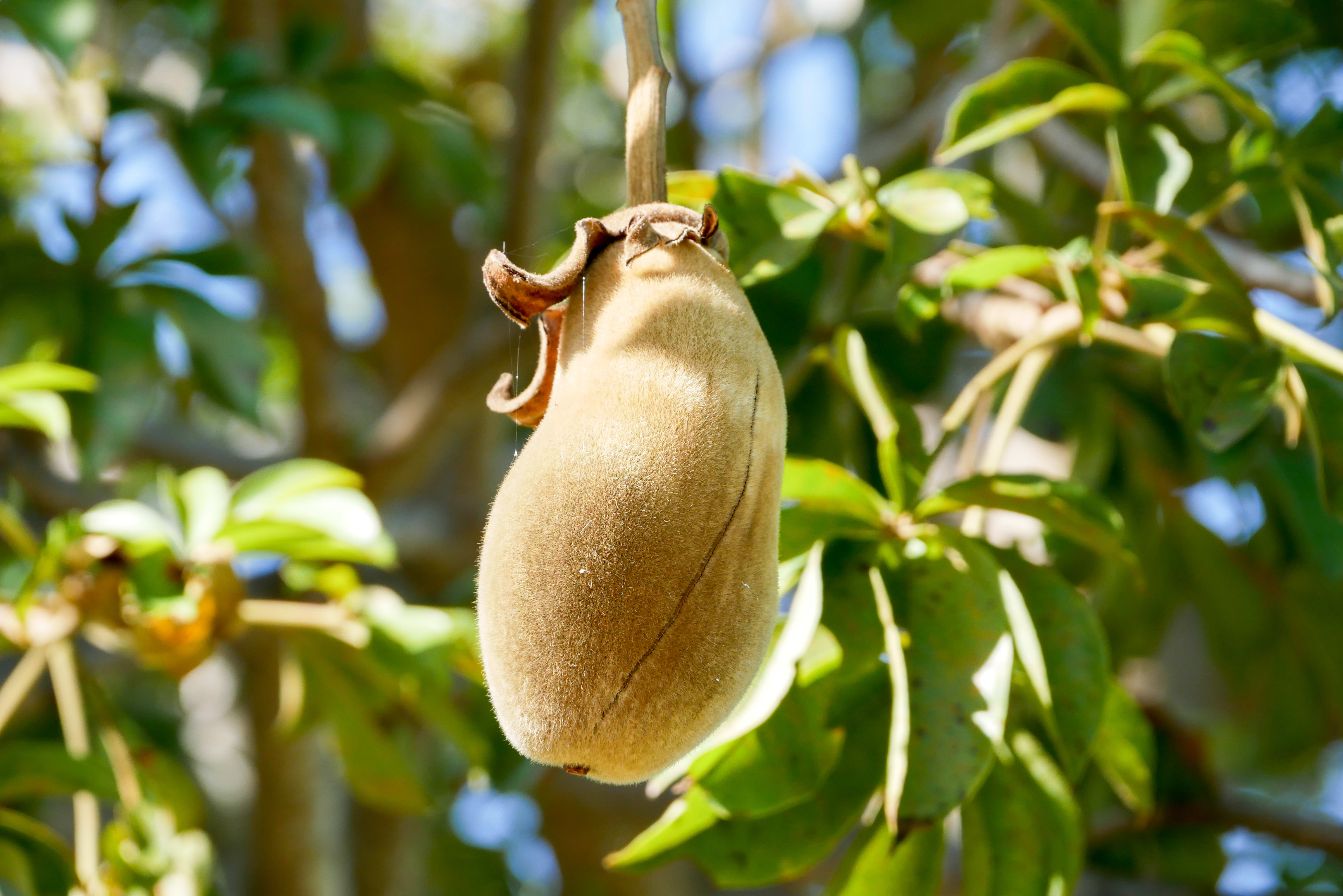
Oceanic drift as a means of transporting plant species is not uncommon. Plus, the pods of boab trees are frequently dispersed in streams and rivers and sometimes out to sea. African boab pods, for example, have been found drifted as far as the Indian ocean island of Aldabra. It is probable that some have made it even further, drifting with the ocean currents to fetch up on the nearest landfall, the north-west coast of Australia.
From the coastal west it would have then spread inland towards the east. Genetic and linguistic evidence suggest that human beings were responsible for this overland movement, particularly across biogeographical barriers, where natural dispersal would be hard to explain.
Aboriginal Uses
The boab tree is known by various Indigenous names among the distinct language groups that share its territory. At Fitzroy Crossing, for example, it is usually known by the Bunuba name, larrgari, while in the Northern Territory around Timber Creek the Ngaliwuru name for it is kuruwan, and the Nungali name, muruwan.
Historically, the people of northern Australia have gotten numerous uses out of the boab trees. One particular value they can provide is as sources of water. Some trees are hollow and collect rainwater that runs off the leafy canopy down the branches into their trunks. Stored in a reservoir or sorts, this water can then be draw upon in times of drought. At other times, the fork between the primary branches of a tree may develop a shallow cavity, which may hold water for a short time after rain. Deeper hollows may also form within the scar left by a fallen branch and hold water.
People used to also extract water out of the bark. With a stone axe or knife they marked out a section of bark, cutting through to the white wood within. They then loosened and pulled down strips of bark, which they chewed to extract moisture, spitting out the fibre when sucked dry.
Many parts of the boab trees can also be used as food. The pulp is edible and can be added to flour when making damper, said to be a good substitute for baking power. The seeds can also be consumed and are a good source of protein and Vitamin C. Historically people would ground them into a paste, which they ate raw. However, as the process is hard and lengthy work no one seems to do it much anymore. Seeds were also sometimes roasted in the coals and eaten whole.

Another favourite still today are the boab trees’ roots. These have a texture similar to a water chestnut and a crunch like a carrot and can be used in a variety of dishes form starters to deserts, stir fries and salads. The leaves can also be eaten fresh. People have experimented with them in salads, and they are said to make a good pesto. Ground into a powder form, they can also be used as an ingredient or thickener for cooking.
Finally, the fruit can be pulled down from the tree and cooked in fire. Or the piths of dry pods picked up from the ground can be smashed with a stone and then soaked in water with honey to make a drink.
Aboriginal people also used the tree’s fibres to make cord. They would cut the root, strip the fibre, arrange it in suitable length, and then rub it back and forth against the thing to make the fibres bind together. The boab string or rope was used for many purposes, including as a shoulder strap for a cradle in which babies and food were carried, to tie around hair, to tie up food storage packages made of paperbark, and, with thicker rope, to tie up canoes to mangrove trees.
Today many Aboriginal artists in the region use the boab fruit pods for their artwork, carving them into ornaments. Because the fruits are likely to crack on impact when they fall to the ground, they are picked from the tree when they are mature and brown but still furry. People then carve intricate pictures over their surfaces depicting human figures, native animals, and local landscapes, representing the intimate connection to the Kimberley region where both the artist and tree grew up. These are then worn as ornaments or sold as souvenirs.
Famous Boab Trees
One of the best-known Kimberly boabs is the Derby Prison Tree, located on the Broome Highway just south of the town. Believed to be 1,500 years old, it has a girth of over 14 metres, a door-sized entrance, and a hollow centre, which could accommodate several people standing, sitting or even lying down. It was used as the last stopover point for prisoners being walked into the gaol at Derby in the early days. Today it is a registered Aboriginal site, culturally significant for the local Nyikina people.
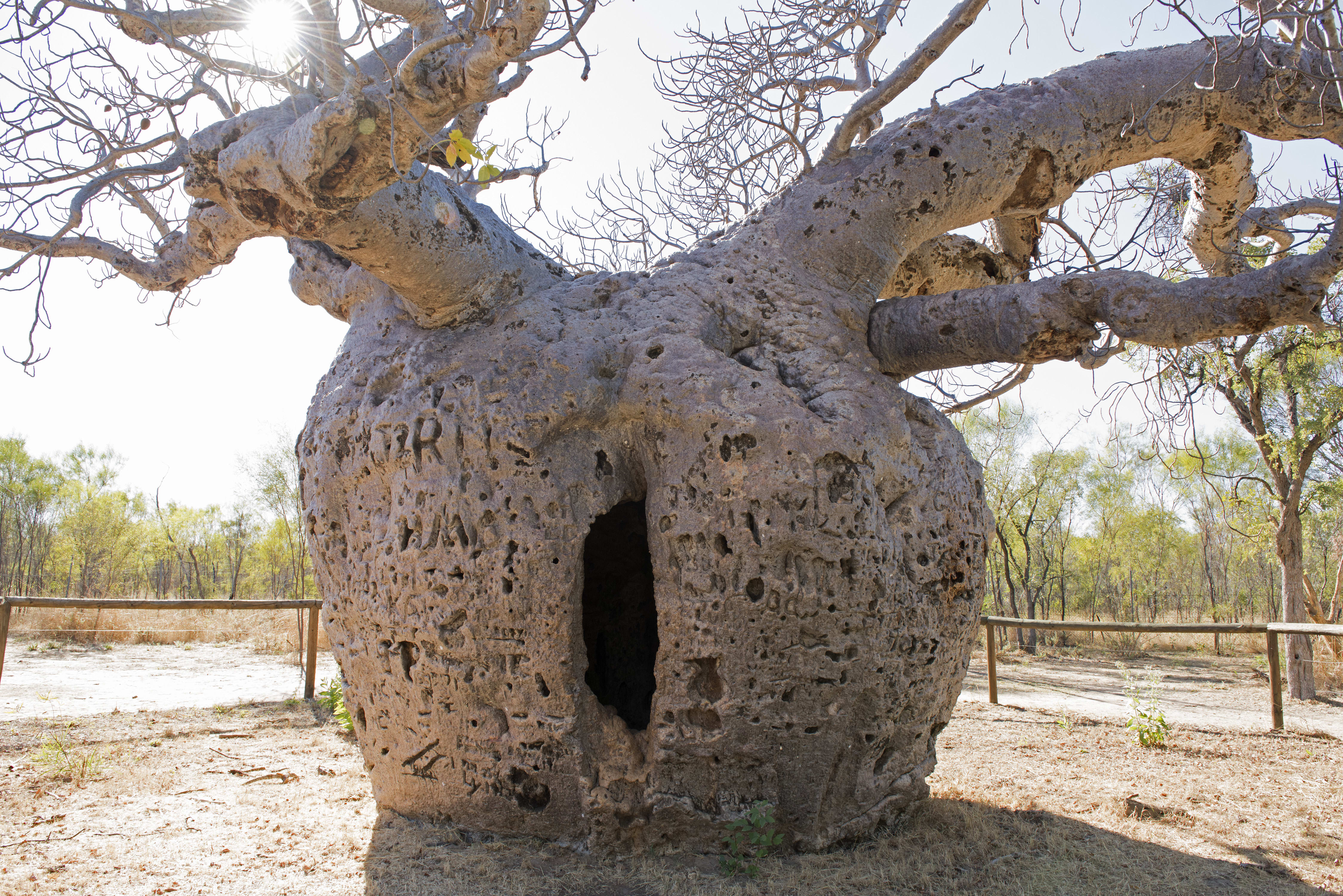
The lesser-known Wyndham Prison Tree was also used as an overnight lock-up. It can be found 23 km along the King River Road (a rough dirt road starting 6 km out of Wyndham). With a circumference of 14.7 metres, it is said to have accommodated up to thirty prisoners at a time. It was an obvious choice for an overnight stop being a day’s travel from Wyndham on horseback and with water nearby. Today the tree, estimated to be between 2000 and 5000 years old, is of cultural significance to the local Aboriginal people, and is fenced off.
Still standing in the tranquil Careening Bay is the Mermaid Tree, carved by the carpenter aboard HMC Mermaid in 1820. The Mermaid’s crew, under the command of Phillip Parker King charting Australia’s northwest coast, had been forced to beach the vessel here due to a leak in the hull. They stayed for 17 days completing repairs, during which King had the carpenter carve ‘HMC Mermaid 1820’ into the bottle-shaped trunk of the boab tree 60km back from the beach.
At the time of the carving, according to the expedition’s botanist, the tree’s girth measure 8.8 metres. Two hundred years later, it measures a mammoth 12.2 metres and the tree has since split into two trunks. The inscription spread across the two trunks now forms an obtuse angle and stands as tall as a person.
Gregory’s Tree in the Northern Territory around Timber Creek is another famous historical specimen. Growing close to the banks of the Victorian River, it marks a stage of the North Australia Exploring Expedition led by Augustus Charles Gregory, which explored the Victoria River basin in 1855-6. In October 1855 the expedition ship, the schooner Tim Tough, was wrecked near the mouth of the river and an entrenchment camp was established here.
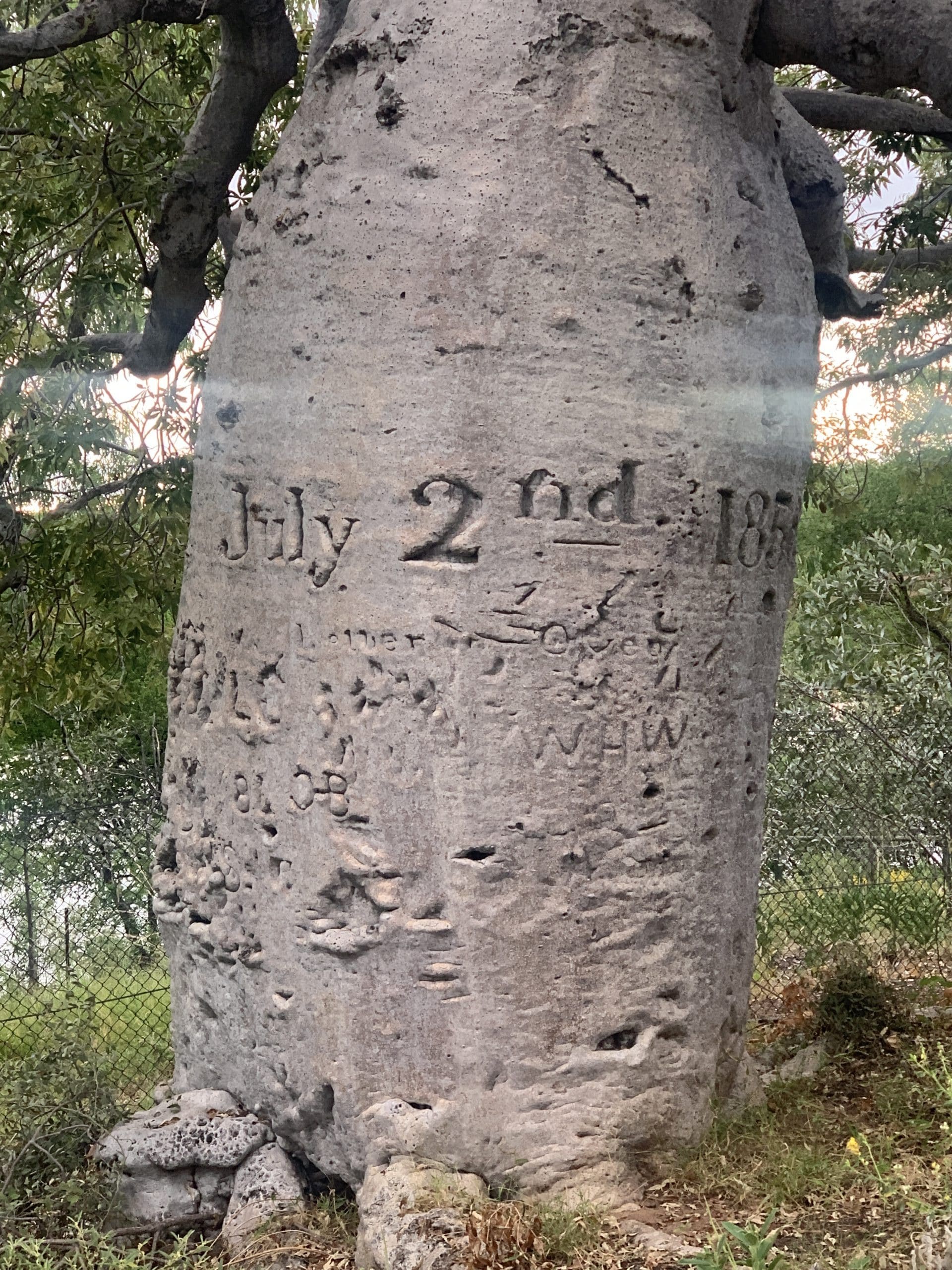
Before leaving the principal camp, the expedition artist, Thomas Baines, marked inscriptions noting the date of arrival and departure from the camp on two boab trees. According to Baine’s diaries, one read: ‘OCTOBER 12 1855 – 1856 LETTER IN OVEN’. The second tree was carved with the words ‘LETTER IN FORGE’. These letters gave details of the expedition’s activities for the benefit of any future explorers and to establish a prior claim.
You can still clearly read the date, 2 Jully 1856, on the Gregory Tree today, but there is no evidence of the earlier date. The rest of the message has been partly obscured by more recent markings.
Alexander Forrest inscribed another historic tree during his Kimberley expedition of 1879. On the eastern side of the tree, there is a well-known ‘F’ above the number ‘69’, marking the expedition’s 69th camp, as well as ‘H’ for Arthur Hicks or Fenton Hill (both members of the same expedition). On the western side are several less distinct markings, including a second ‘69’ carved obliquely beneath the first.
Tour of the Kimberley
Odyssey Traveller visits the Kimberley region and famous boab trees as part of our Tour of Australia’s Kimberley and our Outback Tour of the Northern Territory and Western Australia. Odyssey Traveller’s outback small group package tours are designed especially for mature and senior travellers who want an authentic experience of the fascinating Kimberley region.
Our Tour of Australia’s Kimberley begins and ends in the city of Broome, home to iconic Cable Beach, dinosaur remains at Gantheaume Point, a world-famous bird sanctuary at Roebuck Bay, and a fascinating history as a centre of pearling. From Broome, we head along the pristine Indian Ocean Kimberley coast to Derby, where we visit the Derby Prison Tree, and then turn along the Gibb River Road, making side trips to Windjana Gorge National Park and Tunnel Creek National Park, beautiful Bell Gorge (particularly verdant in the wet), and the easily accessible Galvans Gorge. We head onto the Mitchell Plateau – for many the last frontier of the Australian outback – to admire ancient Aboriginal rock art and the vast Mitchell Falls.
Back on the Gibb River trail, we spend the night at El Questro, near the Northern Territory border, a wilderness park based around Emma Gorge, Chamberlain Gorge, and the Pentecost River. El Questro offers a range of accommodation, from tented cabins to luxury suites in the old El Questro station. Leaving the North Kimberley, we pass Kununurra and Lake Argyle by and make a day tour to Purnululu National Park, where we see the Bungle Bungle range, Piccanniny Creek lookout, Echidna Chasm and Cathedral Gorge. Finally we return to Broome and the West Kimberley, passing through the historic towns of Halls Creek and Fitzroy Crossing.
Our Outback Tour of the Northern Territory and Western Australia explores the Kimberley, Purnululu, Tiwi Islands and Arnhem Land. The tour heads out from Darwin to Timber Creek, home to several historic boab trees, before then heading west through to Kununurra, and delving into Western Australia’s iconic Kimberley region. We then book a light aircraft to visit and stay at Purnululu.
Returning to Kununurra you enjoy a full day scenic flight and tour of the Kimberley taking in icons such as Mitchell falls. After 5 nights in Western Australia, your small group tour returns to the Northern Territory transferring to Katherine and to Jabiru in the UNESCO listed Kakadu National Park. After 3 days exploring the park, the group takes a flight to Nhulunbuy/Yirrkala in the incredible Arnhem land. Returning to Darwin after 6 nights in these amazing UNESCO parks, the group travels with their guide travel out to the Tiwi Islands for 2 nights before returning to Darwin.
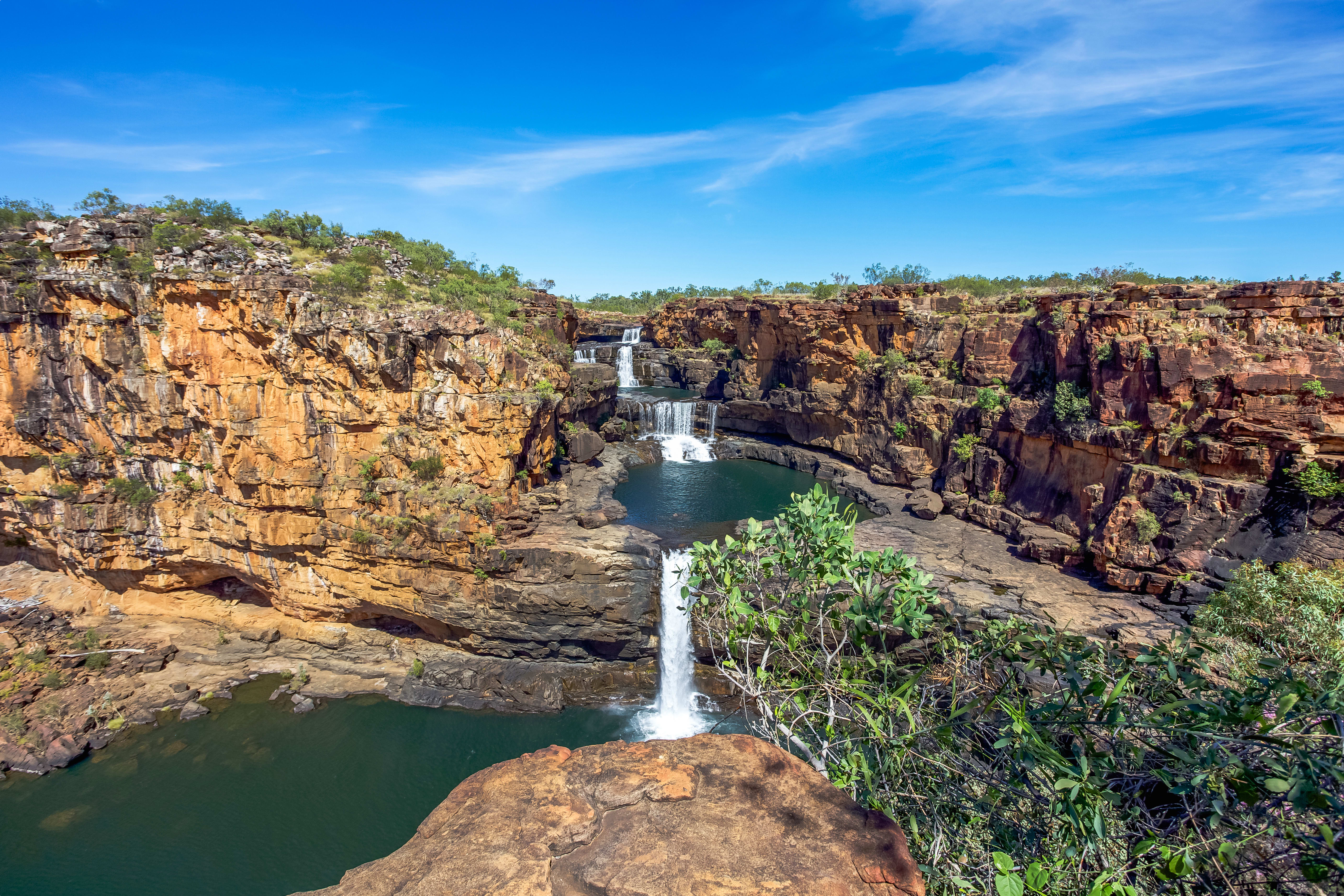
Articles about Australia published by Odyssey Traveller:
- Uncovering the Ancient History of Aboriginal Australia
- Gwion Gwion Rock Paintings (Bradshaw Art)
- Mallee and Mulga: Two Iconic and Typically Inland Australian Plant Communities (By Dr. Sandy Scott).
- The Australian Outback: A Definitive Guide
- Aboriginal Art
For all the articles Odyssey Traveller has published for mature aged and senior travellers, click through on this link.
External articles to assist you on your visit to the Kimberley:
Related Tours
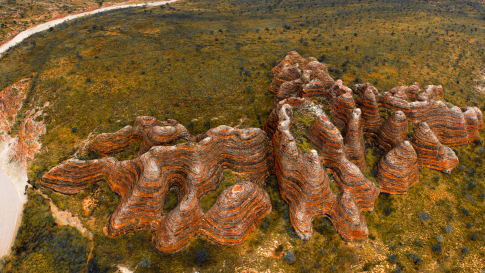
19 days
Sep, Apr, May, Jun, Jul +2Kimberley, Purnululu, Tiwi Islands and Arnhem Land
Visiting Northern Territory, Western Australia
Small group tour touring most of the Australian territory, travelling through the outback and visiting many of the famous sights as well as off the beaten track locations, giving you the opportunity the explore and meet our people in the most remote locations and far north Kakadu and the Kimberley.
From A$14,995 AUD
View Tour
13 days
May, Jun, Jul, Aug, SepSmall group tour of Australia's Kimberley
Visiting Western Australia
Escorted small group tour of the Kimberley. We explore and visit The Bungles, Bell Gorge, Mitchell plateau & Halls Creek in the dry season. Amazing landscapes intertwined with Aboriginal communities resident more than 45,000 years.
From A$15,390 AUD
View Tour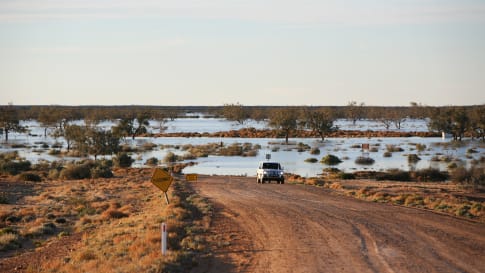
65 days
MarLong tour of Australia for a small group
Visiting New South Wales, Northern Territory
Small group tour for senior couples and solo travellers touring Australia. Travelling through the outback and visiting many of the famous sights as well as off the beaten track locations. Learn about the history of the people who explored the deserts, from indigenous communities to Europeans, as well as Burke and Wills, visit White Cliffs, Marree and far north Kakadu and the Kimberley.
From A$48,995 AUD
View TourArticles
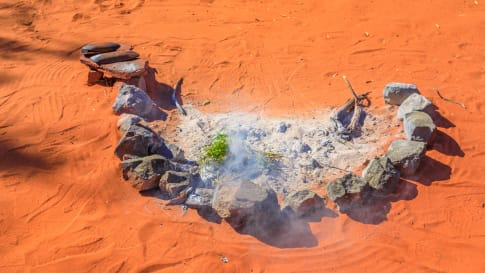
Australian Aboriginal Paths of Migration
Article for small group tours of mature or senior couples or solo travellers interested in learning more about Aboriginal history, Kinship, trading routes, songlines and ancient history.

George Grey's Kimberley Expedition
Article on Western Australia about the Colonial explorer George Grey. Supports small group tours for mature couples and solo travellers of the Kimberley and places of interest such as Wyndham and its pastoral history. The Kimberley is where the first Australian arrived.

Halls Creek, Western Australia
Halls Creek an important stop on our Small group tour of the Kimberley. We learn about the gold rush on this tour for mature and senior travellers, couples and singles.

Kununurra, Western Australia
Explore the sights and history of Kununurra, with its spectacular lakeside beauty and outback charm, Kununurra is one of the Kimberley's most popular highlights. Odyssey offers small group tours for mature and senior travellers, couples, and solo travelers to Australia and Western Australia.

Lake Argyle, Australia
Understand why Lake Argyle exists before joining a small group package tour for mature and senior travellers of Western Australia's Kimberley region in the preferred dry season. Limited to 12 travellers for your peace of mind we learn about the landscapes and the aboriginal stories often via the rock art in far North.

Purnululu National Park, Australia
Read about one of the most remote World heritage sites on Earth. Odyssey takes you to visit as part of a small group package tour for mature and senior travellers in the Kimberley for couple and single travelers We travel in the dry season from Broome via Lake Argyle to this National park.

The Australian Outback: A Definitive Guide
Explore learn and consider what is the outback in this article. For mature and senior travelers considering joining a small group package tours into the outback to see, learn and explore about this unique place, not only the landscape but the Aboriginal approach to living. On each of the tours for couples and the single traveler you learn something different but fascinating, from Outback Queensland, the Flinders, Broken Hill and the Kimberley and the wildflowers all contribute to this question, what is the outback?
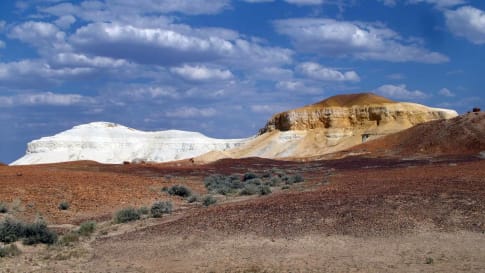
The Kimberley: A Definitive Guide
This article supports the small group package tours for mature and senior travellers, couples and solo travellers to Western Australia's Kimberley region. Learn about the wet and dry seasons and the fascinating Aboriginal history as well as the Bungle Bungles, Lake Argyle, Halls creek and resort of Broome.
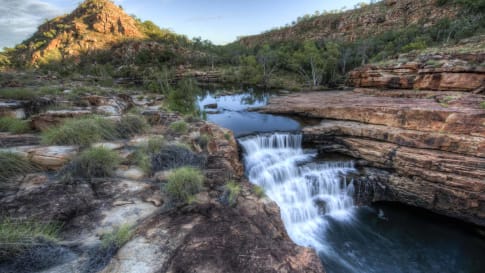
Wet and dry seasons in the Kimberley, Australia
Learn about the wet and dry season in the Kimberley to support your understanding of the Aboriginal communities lifestyle as you explore on a small group package tour for mature and senior travelers exploring as a couple or solo traveller. Read our peace of mind statement for post covid-19 travel.

Wyndham, Western Australia
Article on the historic Kimberley town of Wyndham. Learn about how this was the entry to this part of the Kimberley to Halls creek, and for the pastoralists in the Victorian era. Supports small group tours for mature and senior travellers couples and solo travellers.




